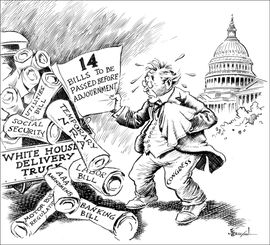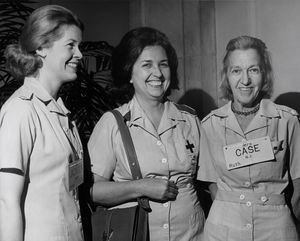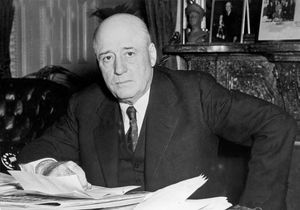The arrival of August means that the Senate is out of session and in the midst of its annual summer recess. Senators’ now-traditional time away from Washington, DC, during the “dog days” of summer can be traced back to the mid-20th century when workloads were growing, legislating was becoming a full-time, yearlong job, and the need to modernize Congress to meet the demands of the 20th century was becoming more evident. In the 1960s, Senator Gale McGee of Wyoming relentlessly worked to convince his colleagues that to modernize the Senate and meet those demands, they would have to take a summer break.

From 1789 until the 1930s, Congress convened for its first regular session in December and typically adjourned in spring or midsummer. After months away from Washington, members of Congress would return for a short second session in December that adjourned on March 3. Occasionally, extraordinary sessions or the demands of war kept Congress in session longer, but generally senators agreed with Vice President John Nance Garner, who reportedly proclaimed, “No good legislation ever comes out of Washington after June.”1
By the late 1950s, however, the schedule had changed and workloads had grown. Adoption of the Twentieth Amendment to the Constitution in 1933 moved the start of each session of Congress to January. The Legislative Reorganization Act of 1946 included a provision that “except in time of war or during a national emergency,” Congress was to adjourn by the last day in July, but this rarely happened in practice. The dramatic growth of the federal government since the Great Depression brought greater oversight responsibilities and increasingly complex appropriations work to lawmakers, all on top of their need to address national problems like civil rights and the challenge of governing the world’s largest economy. From 1949 to 1951, the earliest Congress adjourned was October 19. In 1956 Congress adjourned on July 27—marking the last time the Senate adjourned before the first of August.2
Senators began to feel the effects of these longer and busier legislative sessions. Short tempers and testy exchanges accompanied work in the hot Washington summers. In 1959 Senator Margaret Chase Smith of Maine warned of the Senate’s increasing workload. “The pressures under which Congress works every year at this time of year . . . create disorder,” she complained, as well as “confused thinking, harmful emotions, destructive tempers, unsound and unwise legislation, and ill health with the very specter of death hanging over Members of Congress.” (If that sounds dramatic, keep in mind that in the 1950s, senators died in office at a rate of about two per year.) Smith proposed an annual break from August to mid-November, but the Senate ignored her words of caution.3
In 1960, when the growing workload resulted in another long session that lasted into September, support for a summer recess grew. In 1961 freshman senator Gale McGee proposed an annual break to last from June to October, gaining the support of 32 co-sponsors. McGee argued that the long sessions prohibited many senators from returning to their home states, which had a deleterious effect on their family lives. “We are faced in the Senate with the fact that the work in the Senate is never finished,” he stated, adding it was time “to work out a habit of living that will enable us to rise to these challenges with a minimum disruption of normal family living.” During the 1950s, an influx of younger senators meant that more senators came to Washington with spouses and children in tow. In 1961 there were at least 141 school-age children of senators in and around the DC area. McGee was 46 years old with four children of his own, and almost half of his resolution’s co-sponsors were aged 50 and under.4

Among McGee’s most ardent supporters were many wives of senators and representatives. Bethine Church, wife of Idaho senator Frank Church and the chair of a committee created by the Democratic Congressional Wives Forum and the Republican Congressional Wives Club to study the issue, presented to the Senate Rules Committee a petition of support signed by more than 170 congressional spouses. In testimony to the committee, Church explained that Senate wives typically brought their children back to their home states after school let out for the summer. “It is important,” she stated, “to keep children close to the State which their father represents.” With the Senate in session during the summer, senators stayed in Washington while the family was absent. Once the session ended in the fall, senators traveled back home to meet with constituents (or, in election years, to campaign) just as their children returned to school in Washington. “The average Congressman with school-age children,” Church concluded, “is separated from his family almost half of the year.”5
A summer recess was also popular among senators from the West and Midwest for whom travel back home was costly and difficult to make in the midst of a session. Over two-thirds of McGee’s co-sponsors represented states away from the East Coast. Senator Jack Miller of Iowa stated, “I don’t know a better place in my State for me to obtain true grassroots thinking on problems of people of my State than at the county fairs,” and long sessions meant that he could not attend any of them.6
Unfortunately for McGee, a change to the congressional calendar required the cooperation of the House of Representatives. The Constitution states that neither the House nor the Senate can adjourn for longer than three days without the consent of the other. Speaker of the House Sam Rayburn, a 79-year-old bachelor without children, vehemently opposed a scheduled summer recess, declaring, “It’s the greatest nonsense I ever heard.” In light of this opposition from Rayburn and other older, long-serving members, no action was taken on McGee’s resolution.7

In 1962 the Senate met from January to October with no recess. Just before adjournment that year, McGee renewed his call for a summer recess and got the attention of Senate leadership. In early 1963, Majority Leader Mike Mansfield of Montana expressed support for a summer recess and appointed an informal committee of Democratic senators, led by Senator Mike Monroney of Oklahoma, to suggest ways of speeding up Senate business and changes to the Senate calendar. In March Monroney’s group recommended that the Senate take a short break that session at the end of August. By May, however, Mansfield was already backtracking, saying that a recess would not be possible that year. An anonymous senator, likely McGee, speculated that Mansfield would not commit to an August break since that could be seen as a concession that the session would continue into the fall. That year, the Senate adjourned in December without having taken a break longer than a three-day weekend.8
By 1965 both the House and Senate were prepared to thoroughly examine their way of doing business, and McGee suddenly found himself with a more receptive audience. The Joint Committee on the Reorganization of Congress held more than a dozen hearings that year to explore ways to improve Congress’s efficiency and effectiveness. While McGee still highlighted the benefits of a recess for families, he began to emphasize that a summer break was essential to a broader modernization of the Senate. At a Joint Committee hearing in May, he asserted that “our annual race with the calendar and our perennial guessing game as to when we shall adjourn for the session are symbols of inefficiency and relics of the past.” He argued that mentally and physically tired senators rushed to adjourn at the end of long sessions, leading to good bills being tossed by the wayside while other bills passed without proper debate and scrutiny. McGee argued that a series of scheduled breaks, including a month off in August, would make it “easier, more orderly, and more predictable to pace ourselves during the arduous full legislative year.” The Joint Committee agreed. In its 1966 report, the committee recommended that the House and Senate adopt reforms with the goal of adjourning by July 31, but if the session had to be extended, neither house would meet during the month of August.9

Congress would not adopt the full array of the Joint Committee’s recommendations for a number of years, but in the meantime the Senate was ready to try out a summer recess. In 1968 the Senate took a month-long break in August to allow members to attend the party nominating conventions. If the Senate could break for the conventions in election years, some asked, why not in other years? The following year the Senate recessed from August 13 to September 3. Young reformers gleefully left town, while older senators grumbled. “There’s too much work piling up,” snarled one. “Now we’ll be here till Christmas!” Come September, reviews of the experimental recess were mixed. It certainly was “no vacation,” insisted George Aiken of Vermont, who discovered that his Senate work followed him home. But even critics acknowledged that the break provided useful opportunities for family gatherings and connection with constituents.10
Congress passed the Legislative Reorganization Act of 1970 in October of that year, which mandated that in odd-numbered years both the House and Senate adjourn for a summer recess in August. On August 6, 1971, the Senate began its first official summer recess. While the statute did not mandate a break in even-numbered years—senators chose to maintain flexibility during campaign seasons—the Senate took shorter breaks in August of election years and, beginning in the 1990s, began taking longer August breaks every year.11
On rare occasions, the Senate has chosen to shorten its break or even to forgo the August recess entirely. For example, in 1994 during a heated debate over healthcare legislation, Majority Leader George Mitchell of Maine delayed the Senate’s recess until August 25. The Senate interrupted its summer recess in 2005 to pass an emergency relief bill in the wake of Hurricane Katrina. The Senate cancelled the August recess in 2018 to consider appropriations bills. Such cases remain the exception. By practice and by law, the Senate’s August recess has become a cherished tradition.12
Notes
2. Legislative Reorganization Act of 1946, Public Law 79–601, 79th Cong., 2nd sess., August 2, 1946, 60 Stat. 831. For a complete list of congressional session dates, see “Dates of Sessions of the Congress,” United States Senate, accessed July 14, 2003, https://www.senate.gov/legislative/DatesofSessionsofCongress.htm.
8. “Senate Eyes New Set-Up for Meetings,” Baltimore Sun, January 10, 1963, 1; “Mansfield Proposes Easier Senate Pace, Six Recesses,” Wall Street Journal, January 11, 1963, 5; “Senate Unit Proposes Legislative Speed Up,” Washington Post, March 31, 1963, A2; “Mansfield Does Not Believe Summer Recess is Possible,” Washington Post, May 12, 1963, B2; “To Move Congress Out of its Ruts,” New York Times, April 7, 1963, SM39.
9. Senate Committee on Rules and Administration, Subcommittee on Standing Rules of the Senate, Reorganization of Congress: Hearing on S. Con. Res. 2 and S. 1208, 89th Cong., 1st sess., February 24, 1965; Joint Committee on the Organization of Congress, Organization of Congress: Hearings Pursuant to S. Con. Res. 2, Part 2, 89th Cong., 1st sess., May 20, 1965, 332–38; Joint Committee on the Organization of Congress, Organization of Congress: Final Report of the Joint Committee on the Organization of the Congress, 89th Cong., 2nd sess., S. Rpt. 1414, July 28, 1966, 55–56.
10. “Recess for Congress,” Baltimore Sun, July 22, 1968, A8; Congressional Record, 91st Cong., 1st sess., August 13, 1969, 23660; “Vacation Breather Refreshes Capitol Hill—But Work Piles Up,” Christian Science Monitor, September 13, 1969, 7. For dates of recesses, see the “Sessions of Congress,” Congressional Directory, 117th Cong. 2nd sess., October 2022, 540–58.
11. Legislative Reorganization Act of 1970, Public Law 91-510, 91st Cong., 2nd sess., October 26, 1970, 84 Stat. 1193; Congressional Record, 91st Cong., 2nd sess., October 5, 1970, 34945; “Senate Churns Out Bills, Recesses,” Boston Globe, August 7, 1971, 5; “Regular Recesses Help Congress Do More Work,” Los Angeles Times, October 25, 1975, 1.
12. H. Con. Res. 179, 101st Cong., 1st sess., 1989; “The Longest Debate,” Washington Post, August 19, 1994, G1; “Health Reform Vote May Hang on Senate Recess,” Los Angeles Times, August 23, 1994, A1; Susan Davis, “Mitch McConnell Cancels Senate’s August Recess,” June 5, 2018, accessed July, 10, 2023, https://www.npr.org/2018/06/05/617219548/mitch-mcconnell-cancels-senates-august-recess.